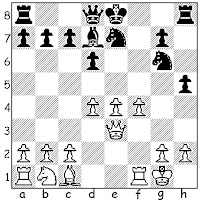When an opening has an established refutation (or several) it can be risky to wander away from it (them). In the following game, Black improvises away from a safe response to the Jerome Gambit (1.e4 e5 2.Nf3 Nc6 3.Bc4 Bc5 4.Bxf7+) - to his own detriment.
Petasluk - KvanHouten
blitz, FICS, 2013
1.e4 e5 2.Nf3 Nc6 3.Bc4 Bc5 4.Bxf7+
4...Kxf7 5.Nxe5+ Nxe5 6.Qh5+ Ke6
7.f4 d6 8.fxe5 Ne7
Black has played "The Annoying Defense" (see 1, 2, 3 for some coverage) 7...d6, which returns a piece and gives White little for his attack to gnaw upon. How annoying!
Yet, the "main line" of "The Annoying Defense" is the consistent 8...dxe5, and Black risks his usual solid position by avoiding the move.
9.Rf1
Creating some pressure on Black.
Previously seen: 9.exd6 Kxd6 10.e5+ Kc6 11.Qf3+ Qd5 12.Qf7? Qxf7 13.d3 Qf2+ 14.Kd1 Bg4, checkmate, GuyEtienne - carssi, FICS, 2008.
9...Ng6
Planning to use the Knight to capture on e5 (instead of the more mundane, but correct, 9...dxe5), but this much improvisation is deadly, a White's previous move was more than a tempo loss.
10.Qf5+ Ke7 11.Qf7 checkmate







































